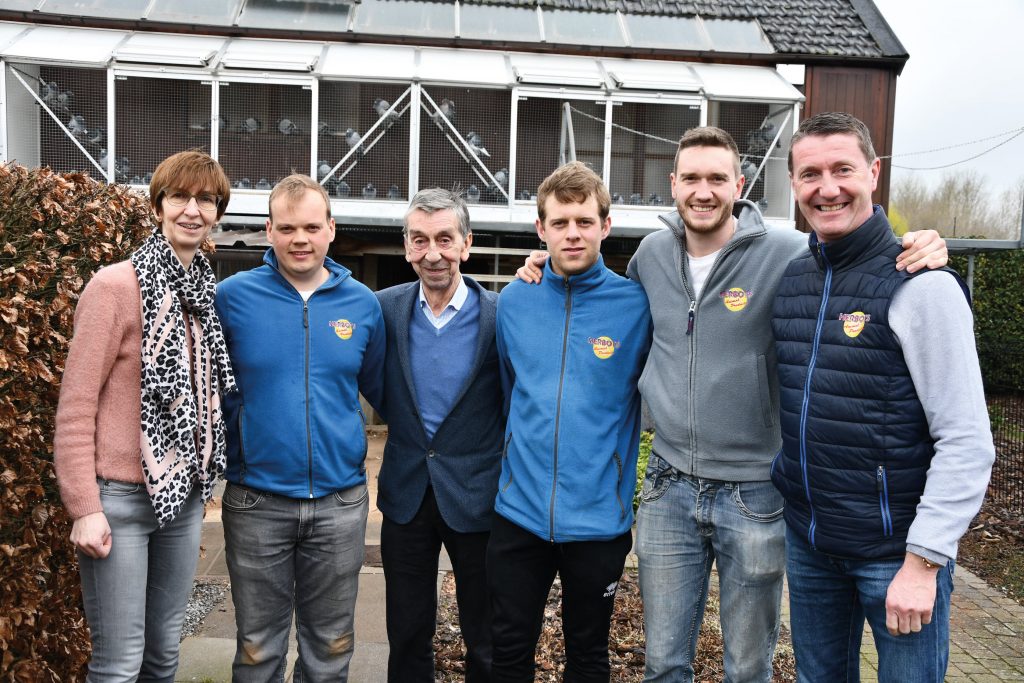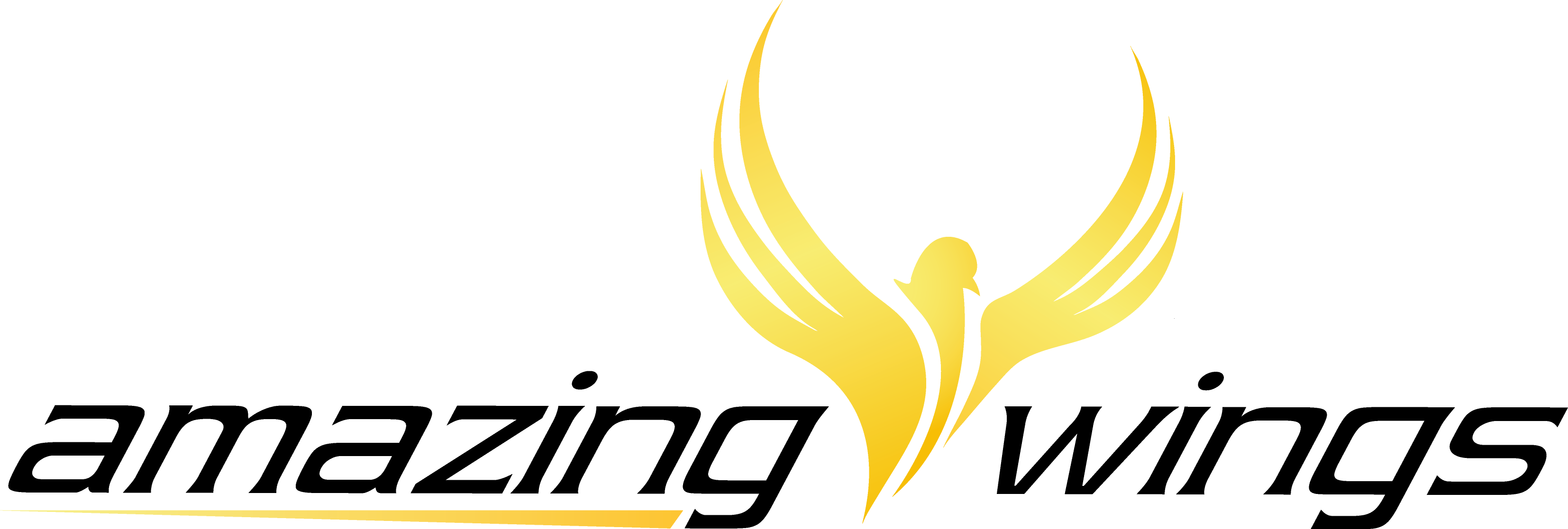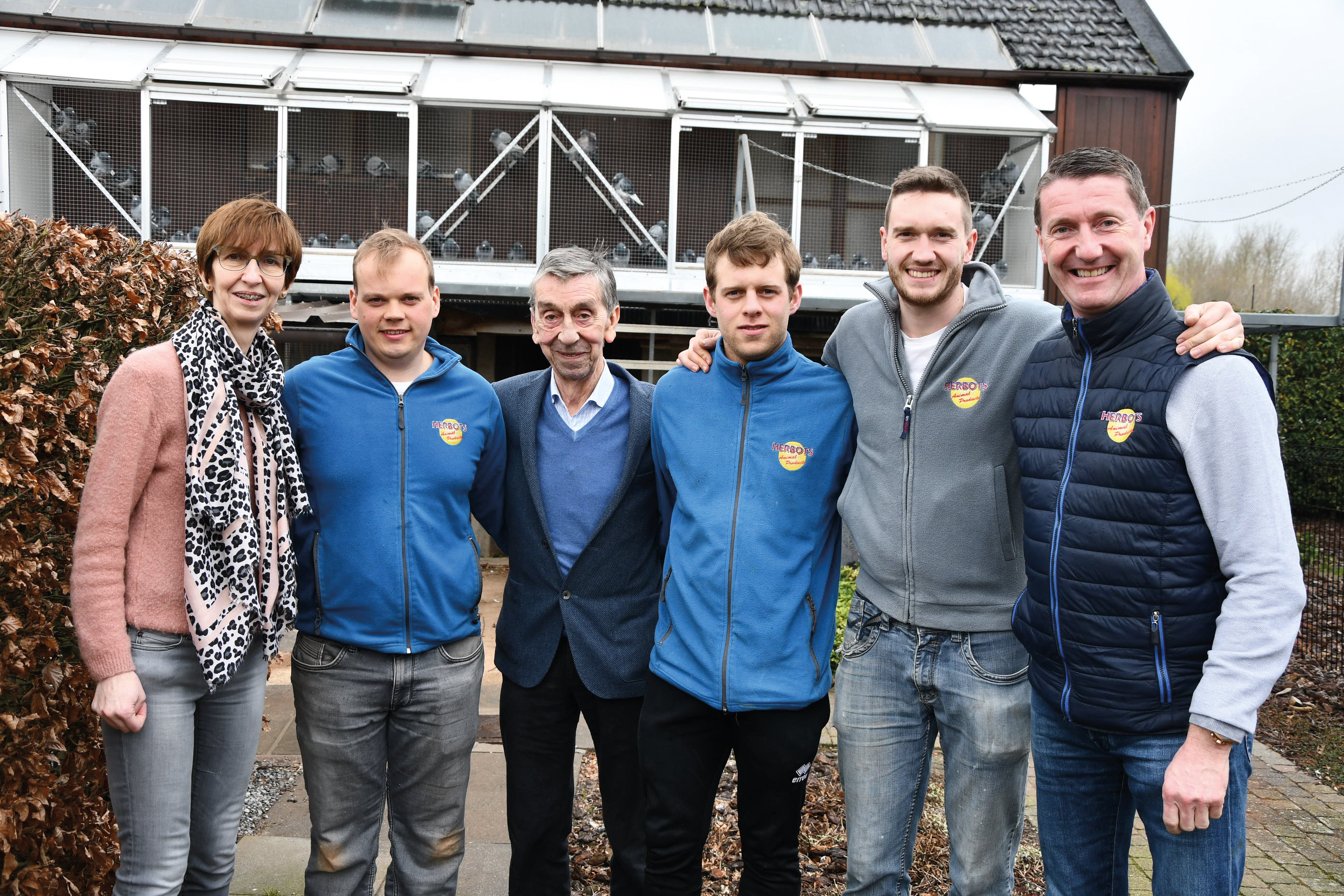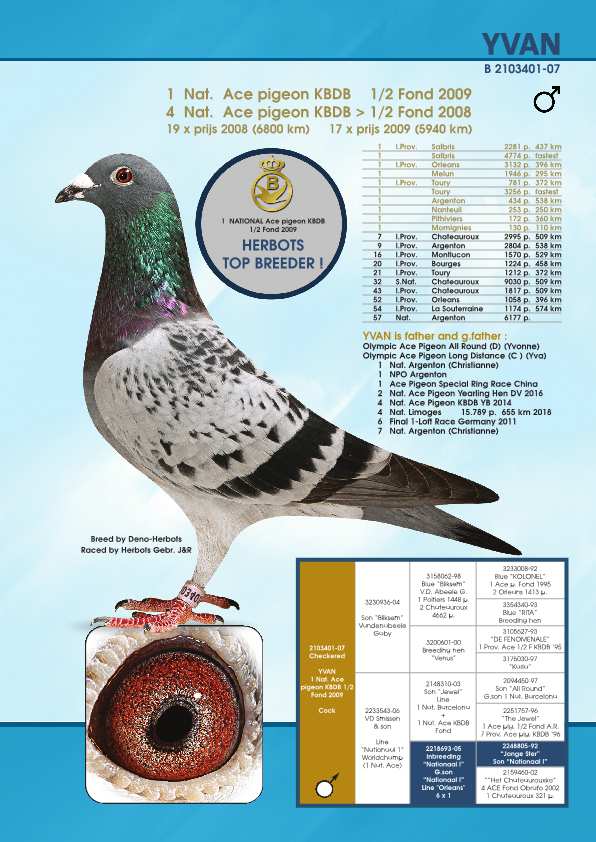Brothers Herbots
- Olympian-Pigeon Allround (Kat. D)
Halle-Booienhoven – Halle-Booienhoven is a municipality near Sint-Truiden. Apart from apples and pears, there were also a number of well-known pigeon breeders in this region, such as Gebr. Clerinx (Nieuwerkerken), Jef Kempeneers (Nieuwerkerken), Emiel Matterne (Overhespen) and Apotheker Daenen (Landen). They contributed to the history of successful pigeon sport in the fruit growing region.

The fantastic team behind the successful colony in Halle-Booienhoven: Geoffrey, Bjorn, Maarten, Filip, Miet and Jo. Without this team, we would not be standing where we are now, say the Herbots in unison.
New names were talked about and these eye-catchers of the last decades include without any ifs and buts Jo and Raf Herbots, who play under the name Gebr. Herbots. After a successful season in 2018, the 1st Olympic pigeon Allround (Cat. D) in Poland was the icing on the cake.
Grandfather Leon Herbots
Father Filip (then 10 years) and his brother Jos (12) had received good grades at school, and so they were allowed to start independently in 1953 with pigeons. Their first pair of pigeons came in the form of eggs from butcher René Becker from Sint-Truiden. The brothers Herbots picked her up with her moped. From the mother’s brother also pigeons came, and so they began in a small blow over the slaughterhouse of the father, who was also a butcher, to play. Filip and Jos played together until Jos married. Father Leon played with his brother, but when Filip and Jos started pigeon racing, he played with them.
When Jo and Raf were 12 and 13 years old, they played independently under the name Gebr. Herbots. Father Filip had made a condition that they should never report their results to the Youth Championship.
Basic Loft
1970 came the first pigeons of Kamiel Dendoven (Zuinkerke). In 1973, pigeons were brought by the Gebr. Clerinx (Nieuwerkerken).
Miel Clerinx and Jos Herbots were close friends. In 1973, pigeons from Frans Stoces (Winterslag) also came, and in 1975 they already
had 110 Stoces originals on the lofts.
In 1980, knocking on Pros Roosen (Kermt). But they turned to even more big names like Jan Grondelaers (Opglabbeek, 1980), Jos Soontjens (Wommelgem, 1988) and Karel Schellens (Kessel, 1991). The most famous Schellens pigeon was the “Nationaal I”, which had won the 1st national Bourges, 1st provincial Orléans and three first prizes on other flights.
In 1991, Jos Soontjens stopped with pigeons and the entire pigeon stock was sold via Herbots to Taiwan, after the pigeons had sat briefly in Halle-Booienhoven. Through these Soontjens pigeons, many top breeders have made a career through Herbots with Soontjens at the base such as Denis Sapin. The best purchase ever was that of the entire stock of Karel Schellens in 1991. There were still pigeons of Van Avondt & son (Haacht, 1999) added, including u.a. “Queen 2000” (1st Nat. Ace-Dove Great Middle Distance at Gebr. Herbots). Later, two more ace pigeons were bought by Van Avondt. “Million” (1st Nat. Ace-Dove Great Middle Distance KBDB) and “Super Million” (2nd Nat. KBDB) came to reinforce the breeding loft.
The Herbots and Jos Deno formed the Schlaggemeinschaft Deno-Herbots. With the batting community Deno-Herbots several pigeons were exchanged, with which was played. One of them is the “Yvan” who nat. In the house of Herbots 2008. Ace Pigeon Big Mid Range KBDB and 2009 1st Nat. Ace Pigeon Small Medium Range KBDB was.
Recently, reinforcements were brought in by Johny Jonckers (Oplinter), Bart Van Oeckel (Oud-Turnhout) and Antony Maes (Waregem), which also resulted in excellent cooperation with these breeders.
Complete widowhood
The Herbots started with 30 old females and 25 old males, who were played on total widower, into the season 2018. In addition there were 60 year old females and 45 year old males. The majority of the yearling team was also played on total widower, Only 24 females were played with 12 males who stayed at home on normal widower.
There were also (initially) 200 youngsters, as well as 25 breeding birds in breeding boxes and 25 breeding pairs (children of the pigeons in the boxes, most of which had flown themselves), who provided the basis.
The 55 old and 105 yearlings pigeons were prepared in the same way for the upcoming season. They were mated for the first time on December 6, at the same time as the breeders. They opened a clutch. After that, the racers were not matched again.
In good weather, training started at the end of March. In four stages, it went up to 35 km. Coming home from the short training flights, males and females gathered in the corridor before beating. After that, they flew 2 x 100 km, 2 x 200 km, and after that the flights of the middle distance began. The pigeons were basketed every week. About 12 old pigeons also took part in the flights of the one day long distance.
From mid-April, males and females train one full hour twice a day. Males and females get together for 1 to 2 hours the day before insertion. They do not come together before basketing. After returning home from a flight, the partners stay together for an hour, but as the season progresses, they may be together until the next day.
If they are trained, old and old pigeons are left on Wednesdays 25 km away. Males and females may come together afterwards. The nest cells are closed during the week and there are sitting boards hung in front of them. The nest cells are opened only when basketing and returning home from a flight.
Very important is the eye of the provider, who observes the behavior of all males and females on Wednesday or after returning from a flight. The “Olympic Boss”, Olympic Dove 2017, owes this title to the connoisseur’s eye of provider Geoffrey. He had noticed that this bird had two females. He had one in his own nest box, and he had another love under a box in the hallway before the blows. As a result, he had his hands full with the defense of his territory, and the result was his Olympic title
- Olympia-pigeon „Chantal“

“Chantal”, B 16-3122016, is the 1st Olympic pigeon Allround in Poland in 2019. She came to the beating in Halle-Booienhoven by exchanging pigeons with Antony Maes (Waregem). She was bred by Antony Maes and played by the Gebr. Herbots. She flew a glittering honor list along with 1st Interprov. Nevers 774 d., 1st Sourdun 740 d., 1st Vierzon 595 d., 2nd interprov. Bourges 3,799 Tb., 2 Momignies 468 Tb., 2 Sourdun 449 Tb., 2 Sourdun 275 Tb., 3rd Interprov. Bourges 2,620 Tb., 4th Interprov. Bourges 2.083 d., 6th Interprov. Châteauroux 1.460 d., 11. Bourges 915 d.
“Chantal” is a rather small hen with dense plumage. She is an attentive dove with a bright mind. She is a quiet hen that is well closed and well muscled. It has “2 working springs” in the wing on both sides and has a perfect eye.
In addition to “Chantal” Gebr. Herbots also with “Golden Sixteen”, B 16-6056655, the 4th Olympic pigeon middle distance. This pigeon originates from Bart & Nance Van Oeckel (Oud-Turnhout). By exchanging with Bart & Nance Van Oeckel, the latter have with B 16-2146231, “daughter Kenzo” and B 16-2146310, “Sister 1st Nat. Limoges “(inbred” Nationaal I “) the 5th and 6th Olympic pigeon long distance.
Youngsters with the sliding door
The 200 youngsters were bred from the breeding pigeons and the main racing pigeons. The eggs of the top breed pigeons were placed under the rice pigeons. The young were dropped at the age of about 25 days, when the plumage was closed under the wing.
The Young Guard will be darkened from April 1st to June 21st. At 4 pm, the shutters will automatically go down. At 11:30 pm, they go back upstairs so the boys wake up at dawn. From 21st June until the end of the season, it will be illuminated from 5.30am to 10.45pm.
With training you make a lot of effort. In about 20 steps it goes from 3 km to 45 km. After that, they are given to the association. If they are trained, they will be left two to three times a week, 45 km away.
The sliding door comes into play the week before the start of national flights. Then cardboard boxes are also set on the lofts, under which the young people can cuddle to their heart’s content. The sexes come together the day before insertion, but it can also occur on the day of use itself. It all depends on the condition and the eye of the provider. The boys train for the widowers, and they have to train for an hour. Of course, the training is important, and it is the scale of the form. At the beginning you train with the flag. Filip Herbots: “The supplier is very important in all of this. Geoffrey recognizes from all pigeons the ring numbers in the air and the descent by heart. That’s the difference between a normal utility and a super utility. ”
Beyers-Mix
Almost all pigeons are basketed each week and are fed according to the same system. The Gebr. Herbots trust the Beyers blends.
After returning home from a flight on Saturday, Energy Galaxy (high-fat blend) is fed. In the drinking water are then electrolytes. On Sunday there is 50% Energy Galaxy and 50% Energy Galaxy Light. In the potions Herbo Aqua Control. As a by-product come alternately 4 Oliën + protein Pro Recup HAP and Tarsin (Herbovet) on the food
On Monday the food is 100% Energy Galaxy Light and Herbo Aqua Control in the drinking water. On by-products there is the same as on Sunday about the food. On Tuesday it stays at 100% Energy Galaxy Light, which is given to Zell Oxygen and Optimix, while in the potions is Herbosol.
On Wednesday morning, 100% Energy Glaxy Light is in the feed channel and Herbosol is in the potion. On Wednesday evening 50% Energy Galaxy Light will be mixed with 50% Energy Galaxy. In the potions is again Herbosol. About the food comes then 4 Oliën and Optimix. In addition, the pigeons get hemp and peanuts.
In addition, the pigeons get every day fresh grit (Herbomineralenmix). Old and young pigeons are fed according to the same system. The youngsters only get many probiotics like Prodigest and Probac 1000 at the beginning. Furthermore, they also use oregano and organic and vita (acids).
Medical accompaniment by Raf Herbots
Raf Herbots is of course the veterinarian on duty. He is consulted every week, with two pigeons from each department being examined. But even here the saying applies: “The less you have to give, the better you fly”.
The travel team is treated with Emdotrim for 10 days before being bred and then vaccinated against paratyphoid fever. While they breed, the pigeons are vaccinated against Paramyxo. In the middle of February, Dokamox will be treated for 8 days to free the pigeons from diseases and then Herbochol will be given for 7 days to cleanse the liver. In the middle of March, the brush is used to vaccinate against smallpox. Herbial then enters the drinking water for 3 weeks to stimulate the down mum and make the breast meat of the pigeons rosy.
In mid-April, Trichomonot was treated with trichomonas for 4 days, and this treatment was not repeated during the season. However, the pigeons got the “yellow drops” and the weekly inspection showed that they were free of trichomonads. Veterinarian Raf Herbots gave the pigeons twice a season a respirator with respitory against respiratory diseases during the season. When the traveling crew gave up, Herbochol was given for several days.
A good loft climate
The lofts are also an important part of a successful pigeon sport. The pigeons who fly on total widower, sit on a strike of 14 m in length, the young pigeons on a strike of 16 m. The breeders are housed in breeding boxes.
It is important that the breeder feels good on his loft, because that is a sign of an excellent whipping climate. In front of almost all blows there are aviaries, and they have a significant influence on the health of the pigeons. The females sit in the aviaries during the day. They come only to eat and sleep inside. The males come only on Mondays in the aviaries to bathe there. The sunlight never falls directly into the blows. It is shielded by frosted glass.
For ventilation, there is a narrow opening at the front of the beats. On the back of the saddle roof, a drainpipe was installed every 3 m. Above the pigeons in the middle of the loft is a ventilation strip. The ATX heating plates are switched on in humid weather and when the pigeons come home after a rainstorm.
The lofts are cleaned twice a day and processed with the vacuum cleaner. The pigeons get a fresh potion every day. It is worked with two sets of potions. One set stands on the blows, while the other dries. In winter, the large cleaning with disinfection of the lofts is on the program.

various
Only outstanding pigeons come after a career of 5 years on the breeding loft. If there is no offspring after one year on the trip, the pigeons are recomposed. If after two years there is still no offspring on the cruise, the pigeons are eliminated. Balancing is avoided as much as possible, because it is trying to breed the perfect pigeon. Inbreeding like father x daughter or mother x son can only be done with real top animals
The backbone of the Herbots Colony form the “Nationaal I” (Schellens) with the “King” (Grondelaers / Soontjens) and “Kenzo” (1st Nat. Ace-Dove KBDB 2007).
For those who experience the Herbots team in action, the question of ambition and dedication is a superfluous issue. This crew is bursting with ambition, and the Olympic idea faster, higher, stronger, this crew is written on the body.
Eye catcher on the breeding loft
- “Young Kenzo 5163265-09, son of KENZO 2116092-04 1st National Ace Pigeon Small Medium Distance KBDB 2007. Young Kenzo was himself a deserving flier and is the father of:
“B13-2172612, who was great on the flights with 1. Interprov. Vierzon 2.402 Tb., 1. Interprov. Bourges 1.241 Tb., 1. Argenton 328 Tb., 2. Interprov. Bourges 1.517 Tb., 2. Interprov. Châteauroux 1.056 db, 2. Sourdun 2.482 db, 3. Interprov. Argenton 1.895 db, 4. Interprov. Montlucon 1.114 db, 8. Interprov. Bourges 2.620 db, 9. Interprov. Châteauroux 1.012 d., 10. Interprov. Châteauroux 1,550 Tb. He also won the 34th Nat. Bourges 9,256 points, 47th Nat. Châteauroux 5,884 points, 56th Nat. Châteauroux 3,933 points, 64th Nat Argenton 13,629 points, 83rd Nat. Argenton 1,759 TB, etc.
He became father of:
– “Blauwe Parel” B11-2186203 with 4th Olympic Dove Cat. B Nitra 2013, 5th Olympic Dove Cat. D Nitra 2013, 1st Ace Pigeon LCB Yearlings 2012 and 1st Interprov. Ace Pigeon middle distance yearlings Liège-Haspengouw
– “B18-2135035” with 2nd Argenton 138 Tb., 8th Châteauroux 1,430 Tb., 10th Bourges 1,524 Tb., 45th Châteauroux 1,131 Tb. He was 1st Interprov. Ace Pigeon youngsters middle distance 2018 and 3rd Prov. Ace Pigeon KBDB middle distance 2018.
* “B14-2313090” x B11-2186012. The father is an inbred product on the “Nationaal I” and the mother comes from the old line of “Number 2” (“Son of the 155 Soontjens”) with De Rauw-Sablon. They became the parents of B17-2140001, B17-2140002 and B17-2140336 who won the following prizes: 2. Nat. Zone Argenton 2.855Tb./4. Nat. Argenton 8,818 d., 1st Interprov. Châteauroux 721 d., 2nd Argenton 191 d., 3rd Vierzon 621 d., 4th Momignies 329 d., 11th interprov. Tulle 1,527 Tb., 14th Chevrainvilliers 846 Tb., 25th Interprov. Vierzon 4.407 Tb., 43. Interprov. Vierzon 1.528 Tb., 57. Interprov. Bourges 2,731 Tb.
* “Super Argenton” B11-6329744. He became father of:
– “B18-2135089” with 3. Interprov. Châteauroux 1.430 Tb.
– “B18-2135310” with 5. Interprov. Châteauroux 1.430 Tb.
– “B16-2146298” with 6. Interprov. Argenton 2.251 Tb.
– “B16-2146765” with 1st Interprov. Bourges 1,517 Tb., 1. Bourges 339 Tb., 1. Chevrainvilliers 101 Tb., 2. Vierzon 283 Tb., 4. Soissons 340 Tb., 5. Châteauroux 835 Tb., 5. Sourdun 740 Tb., 7. Interprov , Bourges 1,397 Tb., 9th Interprov. Vierzon 2.394 Tb. He was 5th Olympic Dove Cat. H 2019, 1st Prov. Ace Pigeon KBDB Big middle distance old birds 2018 and 4. Prov. Ace Pigeon KBDB Allround 2018 .
two absolute Cracks

* “Yvan” B07-2103401 with 1st Interprov. Salbris 2,281 Tb. (Fastest of 4,774 Tb.), 1st Interprov. Orleans 3.132 Tb., 1. Melun 1.946 Tb., 1. Interprov. Toury 781 Tb. (Fastest of 3,256 Tb.), 1st Argenton 434 Tb., 1st Nanteuil 253 Tb., 1st Pithiviers 172 Tb., 1st Mom. 130 Tb., 7th Interprov. Châteauroux 2,995 Tb., 9th Interprov. Argenton 2.804 d., 16th Interprov. Montlucon 1,570 Tb., 20th Interprov. Bourges 1,224 Tb., 21st Interprov. Toury 1.212 d., 32. semi-nat. Châteauroux 9.030 d., 43. Interprov. Châteauroux 1.817 d., 52. Interprov. Orleans 1.058 d., 54. Interprov. La Souterraine 1.174 d., 57. Nat. Argenton 6,177 Tb. He became 4th Nat. Ace Pigeon Great middle distance 2008 and 1st Nat. Ace Pigeon Small middle distance 2009.
* “Big Boss” DV1274-272-10 mit 1./2.127 Tb. (615 km), 1./3.496 Tb. (329 km), 1./2.080 Tb. (420 km), 1./1.874 Tb. (313 km), 2./3.159 Tb. (429 km), 2./1.237 Tb. (313 km), 6./3.587 Tb. (154 km), 7./4.168 Tb. (544 km), 9./5.183 Tb. (429 km), 11./2.219 Tb. (313 km), 13./2.649 Tb. (420 km), 16./3.756 Tb. (429 km), 23./3.262 Tb. (233 km), 31./4.928 Tb. (315 km), 37./3.517 Tb. (233 km).
He became 1st Nat. Ace Pigeon of Germany 2012, 1st Olympic pigeon middle distance Nitra 2013 and 1st Olympic pigeon Allround (11 flights) 2013
Children of “Big Boss” won 1st Interprov. Châteauroux 1.511 d., 1st semi-nat. Vierzon 1,997 Tb., 2nd Interprov. Châteauroux 1.131 d., 3rd interprov. Argenton 1,029 Tb., 4th Interprov. Châteauroux 1.535 d., 4th interprov. Argenton 854 d., 5th semi-nat. Bourges I 2.715 d., 5th interprov. Bourges II 1,817 d., 7th Interprov. Châteauroux 1.993 d., 7. Interprov. Bourges 1,236 Tb., 10th Interprov. Bourges 3,799 Tb., 10th Interprov. Châteauroux 1,460 Tb.



